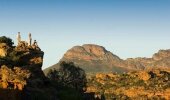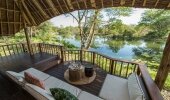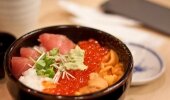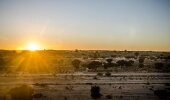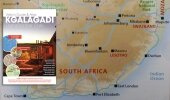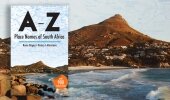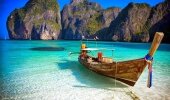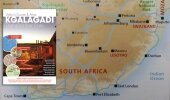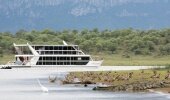Words & Photos: Xen & Adri Ludick
Tsumkwe to Epupa Falls - Some wise traveller wrote, “Great journeys are memorable not so much for what you saw, but for where you camped.”
Following on from my previous article in DO IT NOW, Xen and I had left Tsumkwe, a small settlement inhabited by bushman in the north-eastern section of Namibia, and were on our way to Etosha, a fantastic wildlife destination we were eager to visit again.
We travelled on the C44, a good gravel road, for about 188km until we reached the B8 tar road. Here we turned south to Grootfontein and then north to Tsumeb. Most of the journey was in the pouring rain and progress was slow. We decided to stay over at the Namutoni campsite in Etosha for two days, a popular campsite and very different from what we are used to; wide open expanses, with no humans in sight. However, one is always assured of meeting interesting people and seeing their unique behaviors. To give you an example, we would put up the roof tent, set out our chairs and table, with a tablecloth and candles, and then just relax. On our first night, we saw a gentleman and lady sitting in a Sedan, with the interior lights on and reading. They didn’t have a chair or table, only a very small tent. Next to us was the friendly couple from Holland, who Xen had tried to help as they were having mechanical problems with their hired camper. Their large camper had bright neon lights and they sat inside the whole evening talking and drinking. There was also another camper, with a bright neon light burning and a yellow light beaming down on the camper’s entrance, but we never saw the occupants. Sitting quietly at our fire and watching these people, we witnessed the most beautiful full moon rising, sounds of hyenas, jackals and lions filling the air and we asked ourselves, “Did they hear it, did they see it and what stories are they going to share when they get back home?”
Etosha was wet! The Etosha Pan looked like False Bay and we struggled to see where the water ended. During our game drive we saw herds of giraffe, red hartebeest, kudu, gemsbok, zebras, impalas and springbuck. We also saw abdim storks, loeries, flamingos and even water tortoises. Although we try not to camp near people, Etosha was everything we remembered and more.
Despite being warned about the flooding in northern Namibia, we decided to proceed and explore for ourselves. The next day we exited Etosha at the King Nehale gate and from there onwards all we saw was water. On the way from Ondangwa to Oshakati we passed little shebeens, with interesting names like ‘The Feel Good Never Loose Bar’. All along the road people were catching the Okavango fish, which look like a barbel, in the rising waters.
Arriving at Khutsi Reserve, we mistakenly occupied the incorrect campsite. However, the gentleman that arrived was kind enough to allow us to stay in his campsite, while he occupied ours. We met up again in Etosha and shared many a whiskey over stories about travelling, the newest trends in 4x4 vehicles and precautions to take when travelling in Africa. One of the things we spoke about was how to secure your vehicle when refuelling at a filling station. The view was that one should always lock your vehicle when you get out. Well, while Xen was refuelling in Oshakati, I quickly ran to the general store and neglected to lock the vehicle. As a result, a youngster opened the door on the opposite side of the vehicle to where Xen was standing and removed our Sony camera and 500mm lens. We learnt the hard way, as we lost many of our precious photos of Khaudum and Etosha.
From there we headed towards Ruacana where the falls were in full flood after the good rains and the Kunene River was a seething, thundering mass of water tumbling into the 120m deep gorge. We overnighted at the Hippo Pools community campsite, but were unable to travel on the river route via Swartbooisdrif to Epupa Fall the next morning due to flooding, so we turned south to Opuwo.
Opuwo was bustling with Herero women wearing padded headgear and full-skirted dresses, mostly in bright green and red colours, while the Himba women were barefoot and bare-breasted. We got stranded in the middle of the town for about an hour, waiting for a funeral procession of Herero and Himba people to proceed through. Upon enquiring about the funeral procession, we were told that the Chief of the Herero people had passed away, and the Herero and Himba people from all over Namibia had come to pay their respects. Hearsay stories said that he was a young attorney, who promised himself that he would never drink alcohol, but when he did he committed suicide. Although he was in conflict with his brother, he did a lot to bring the Herero and Himba people together. While we were waiting for the procession to pass, a young farmer told us that he had shot springbok and zebra for the feast after the funeral.
The 178km road from Opuwo to Epupa Falls is beautiful; it’s green and very hilly, with many Himba mud and stick-domed huts. We crossed numerous dry rivers, which can cause damage to your vehicle if you travel too fast, and stopped often to greet the Himba children, who greeted us with a ‘goodbye’ instead of ‘hello’. Besides asking for ‘sweeeets’, they also asked for water, not cool drinks.
As we crossed over a hill, we were suddenly faced with the imposing Kunene River and Epupa Falls, one of Kaokoland’s most breathtaking sights. The river fans out into a number of channels before cascading into a deep, tumultuous gorge. Our camp at Epupa Falls Resort was situated about 10 metres from the strong-flowing Kunene River and under huge Makalani Palms. There was a bit of flood damage and the sand was very moist, as the river had only subsided earlier that week. Once we had set-up camp, we took a walk to the top of the closest hill and enjoyed the most incredible view of about 17 waterfalls.
The next morning a local guide took us to a Himba village. We took flour, sugar, soup, oil, rice, mealie meal and other food items, as gifts for the head lady. The guide first negotiated with the head lady and then asked permission for us to visit their homestead, and she welcomed us with open arms. We went into the kraal and watched a young herdsman milk a cow. His hair was shaped in a horn-shaped ponytail and he explained to us how the Himba’s remove the bottom four front teeth, which identifies them as Himba and allegedly improves their speech. The teeth are knocked out with a stick when they are between 16 and 18 years old, and this usually takes place during winter, to prevent infection. We also met a woman who was busy repairing her hut with a mixture of clay and cow dung. She was able to speak a bit of English and had a great sense of humor. The children attend a Himba school and this is where they are taught English.
She took us into her hut and explained their fascinating lifestyle to us. There is no door to the hut, and a fireplace in the middle of the room provides heat for the occupants and keeps out any unwanted wild animals. There is a cattle skin on the floor for them to sleep on. The women never bath, instead they cover their bodies twice a day with a fine ocher powder that is sourced from the mountains in Angola. The powder is mixed with butter and kept in a cow hoof. The butter is made by putting milk in a calabash and rigorously shaking it until butter is created. Their hair is twisted in long strings and covered with red mud. The children’s hair is plaited to the front, but as soon as a girl becomes a woman, their hair is twisted to the back and covered with red mud. If the hair is too short, hair from a cow’s tail is used to make it longer. The more modern women buy pieces of hair from the local stores and have a collection of head pieces for different occasions. Their daily dresses are made from goat’s skin, while a dress from cow leather symbolizes wealth and status. The dresses are fragranced by placing the dress over coals doused with herbs.
The Himba make beautiful jewellery to generate income from tourists. Xen bought me a lovely necklace made of porcupine quills and watermelon pips for only $N40. They wear heavy jewellery made of mud, copper, wire and beads. When a Himba dies, they are wrapped in the cattle skin they slept on and buried immediately. There are different smaller shelters, each with a specific purpose. Some shelters are for the hens to lay their eggs in, others are where the young goats stay when the older ones head into the veld for grazing and then there are storerooms. As soon as a young boy becomes a man he has to gather his own cattle, and a man’s wealth is determined by the size of his herd and amount of wives he has.
After such an interesting day, we headed back to our camp and saw a water monitor catch a frog right in front of our campsite. Later that evening we had a bad experience when Xen tried to shuffle the coals so that I could bake bread. He inhaled too much smoke, started coughing, then fainted for a few seconds and fell into the fire. With strength beyond understanding I pulled him out of the fire and because he was wearing nylon basketball shorts, he ended up with a third-degree burn, as big as a man’s hand, on the side of his bum. Luckily we have a comprehensive medical kit, so I was able to dress the wound properly. Firstly, I immediately put as much burn gel as possible onto the wound, which stopped any blisters from forming. Secondly, I cleaned the wound with diluted salt water and a small amount of Dettol. Then I dressed the wound with Bactroban, Jellonet and lastly gauze. As we were more than 250km from the closest pharmacy, I compromised to save plasters by using cling wrap over the gauze, taped it with plaster and then bandaged it well. Although it was uncomfortable and very painful, some Myprodols, antibiotics and Panados helped us to finish our trip. Before we left, Xen had told me to purchase burn gel and I obtained three small packets, as I only thought of a small burn wound. I can assure you that on our return, our medical kit will have a huge container of burn gel in it.
In the next issue of DO IT NOW I look forward to sharing more stories with you as we make our way to Kaokoland, one of the last remaining wilderness areas in southern Africa and home of the Himba people, and Damaraland, one of the most scenic areas of Namibia and where we hope to encounter the famous desert elephants.
